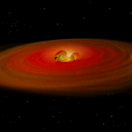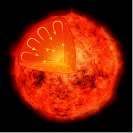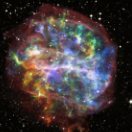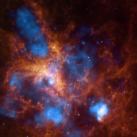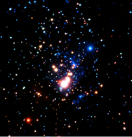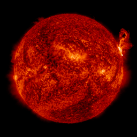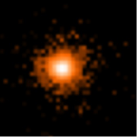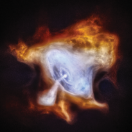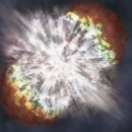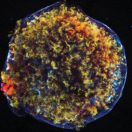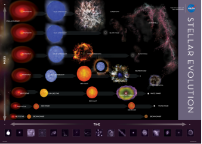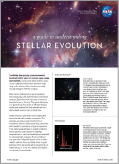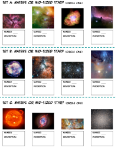
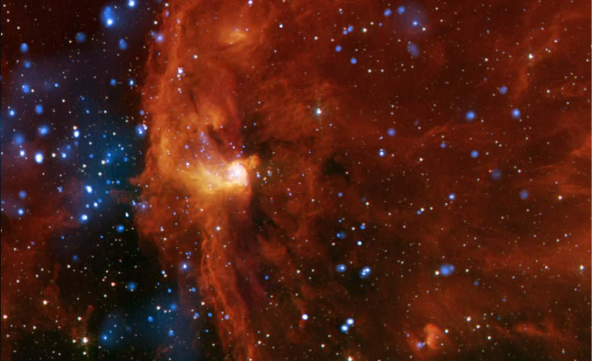
When the Universe came into existence ~14 billion years ago, the only elements were hydrogen, helium, and traces of lithium, beryllium, and boron. The heavier elements did not yet exist. Heavy elements are produced by nucleosysthesis - the fusion of nuclei deep within the cores of stars. At some point in time, the first stars were formed, and within their cores the fusion process created heavier and heavier elements; the most massive stars produced nuclei as heavy as iron. When the stars used up their nuclear fuel, they started to evolve.
The evolutionary processes of stars depend upon their initial mass. Mid-sized stars eject planetary nebulae, leaving a white dwarf core remnant. More massive stars explode as supernovae, leaving neutron stars or black holes at the centers of the supernovae remnants. The elements that were created within the
cores of the first stars were ejected into space where they intermingled with the surrounding interstellar medium. This medium — the gas and dust between the stars — provides the raw material for the formation of new generations of stars. Eventually, these elements became incorporated into large clouds of gas and dust that condensed and formed protostars. And so the cycle of stellar formation and destruction continues. Each new generation further enriches the interstellar medium with heavy elements that become incorporated into the next generation. We are just beginning to understand stellar formation and destruction —and how the Sun, Solar System and life on Earth are connected to this never-ending cycle.



The Milky Way galaxy contains several hundred billion stars of various ages, sizes and masses. A star forms when a dense cloud of gas collapses until nuclear reactions begin deep in the interior of the cloud and provide enough energy to halt the collapse. Many factors influence the rate of evolution, the evolutionary path and the nature of the final remnant. By far the most important of these is the initial mass of the star. This interactive piece illustrates in a general way how stars of different masses evolve and whether the final remnant will be a white dwarf, neutron star, or black hole.
Stellar evolution gets even more complicated when the star has a nearby companion. For example, excessive mass transfer from a companion star to a white dwarf may cause the white dwarf to explode as a Type la supernova.
The following tableau provides a few examples of stars at various evolutionary stages, and what Chandra has learned about them. X-ray data reveal extreme or violent conditions where gas has been heated to very high temperatures or particles have been accelerated to extremely high energies. These conditions can exist near collapsed objects such as white dwarfs, neutron stars, and black holes; in giant bubbles of hot gas produced by supernovas; in stellar wind or in the hot, rarified outer layers, or coronas, of normal stars.


Q: When will the next supernova explosion be?
A: It's not possible to predict when the next supernova explosion will be, but you don't have to wait very long. Throughout the Universe, countless supernova explosions happen every day. In our own galaxy, there probably hasn't been a supernova explosion for hundreds of years. Astronomers have identified several large, unstable stars in our galaxy that might be the next to explode, but they can only guess when such an explosion might happen. In distant galaxies where individual stars cannot be seen, it's obviously even harder to make predictions.
Q: Why do neutron stars have strong magnetic fields?
A:
Neutron Star Illustration
A neutron star is formed when a massive star collapses - if the star has a magnetic field of approximately the strength of the Sun's magnetic field (a few gauss), the magnetic field is compressed when it collapses and the field is amplified by the ratio of the volumes (again approximately), which is 1.25 x 1014. Please see this page for details:
The Chandra pages have a plethora of information on neutron stars and stellar evolution. We suggest you start here: and note that pages 11 and 12 of this section contain the neutron star information, although the entire section will help you understand the process of stellar birth and death.
Q: What are five differences between white dwarfs and neutron stars?
A: The major difference is due to the way in which they are formed.
- White dwarfs are formed from the collapse of low mass stars, less than about 10 time the mass of the Sun, in which the star loses most of its mass in a wind, leaving behind a core that is less than 1.44 solar mass, whereas neutron stars are formed in the catastrophic collapse of the core of a massive star.
- A white dwarf is supported by electron degeneracy pressure, a neutron star by neutron degeneracy pressure
- A white dwarf has a larger radius --about 600 times
- A neutron star has a stronger gravitational field -about 400,000 times
- Neutron stars have higher temperatures at birth, spin faster, and have stronger magnetic fields, among other things .
Q: Where in the galaxy would you expect to find Type I and Type II supernovas?
A:
The two basic types of supernovas are Type Ia and Type II. Other types, such as Types Ib and Ic, are unusual supernovas that have most of the properties of type II supernovas.
Type Ia are believed to be triggered by a large transfer of mass from a companion star onto a white dwarf that pushes the white dwarf over the Chandrasekhar limit. A thermonuclear explosion follows, blowing the entire star apart, and sending material rich in iron and other products of the explosion rushing out into space. Since a white dwarf is involved, Type Ia supernovas are expected to be found among old star systems, such as globular clusters, the central bulges of galaxies and elliptical galaxies.
Type II supernovas are thought to result from the collapse of a massive star (ten or more times as massive as the Sun) that has reached the end of the red giant stage of evolution, and formed an iron core. The core collapses under the weight of the outer layers of the star. A neutron star is formed, lots of neutrinos and other radiation is emitted, and everything except the neutron star is blown away. Since massive stars are involved, Type II supernovas are found in the spiral arms and other star-forming regions of spiral and disk galaxies, which have lots of gas and dust for the formation of new stars.

Stellar Nursery: Large cold clouds of dust and gas where stars form.
Protostars: The stage in the formation of a star just before nuclear reactions ignite.
Brown Dwarf: An object with a mass less than about 8% of the mass of the Sun, but about 10 times greater than that of Jupiter.
Red Dwarf: A star with a mass between about 8% and 50% the mass of the Sun.
Sun-Like STAR: A star with mass between about 50% and 10 times that of the Sun.
Blue Supergiants: Stars much more massive than the Sun.
Red Giant: A phase in the evolution of a star after nuclear fusion reactions that convert hydrogen to helium have consumed all the hydrogen in the core of the star, and energy generated by hydrogen fusion in the shell causes the star’s diameter to greatly expand and cool.
Blue Giant: After a massive red giant star ejects its outer layers, its hot inner core is exposed, and it becomes a blue giant star.
Planetary Nebula: A nebula produced after an exhausted giant star puffs off its outer layer and leaves behind a smaller, hot star.
White Dwarf: The end phase of a Sun-like star in which all the material contained in the star, minus the amount blown off in the red giant phase, is packed into a volume one millionth the size of the original star.
Neutron Star: An extremely compact star produced by the collapse of the core of a massive star in the supernova process.
Blackholes: If the core of a collapsing star has a mass that is greater than three Suns, no known force can prevent it from forming a black hole.
Type Ia Supernova: An explosion produced when a white dwarf becomes unstable due to the accretion of too much material or merger with another white dwarf.
Type II Supernova: A supernova that occurs when a massive star has used up its nuclear fuel and its core collapses to form either a neutron star or a black hole, triggering an explosion.
Pair-instability Supernova: A rare type of explosion predicted to occur as a consequence of the extremely high temperatures in the interiors of stars having masses of about 200 suns.
Supershells: The combined activity of many stellar winds and supernovas create expanding supershells that can trigger the collapse of clouds of dust and gas to form new generations of stars.
End phases: A star’s ultimate fate depends on its mass. It can fade into obscurity (brown dwarf or red dwarf), become a white dwarf (sun-like stars), explode as a supernova and leave behind a neutron star or a black hole (massive to very massive stars), or be disrupted entirely (white dwarfs in close binary systems, or extremely massive stars).


